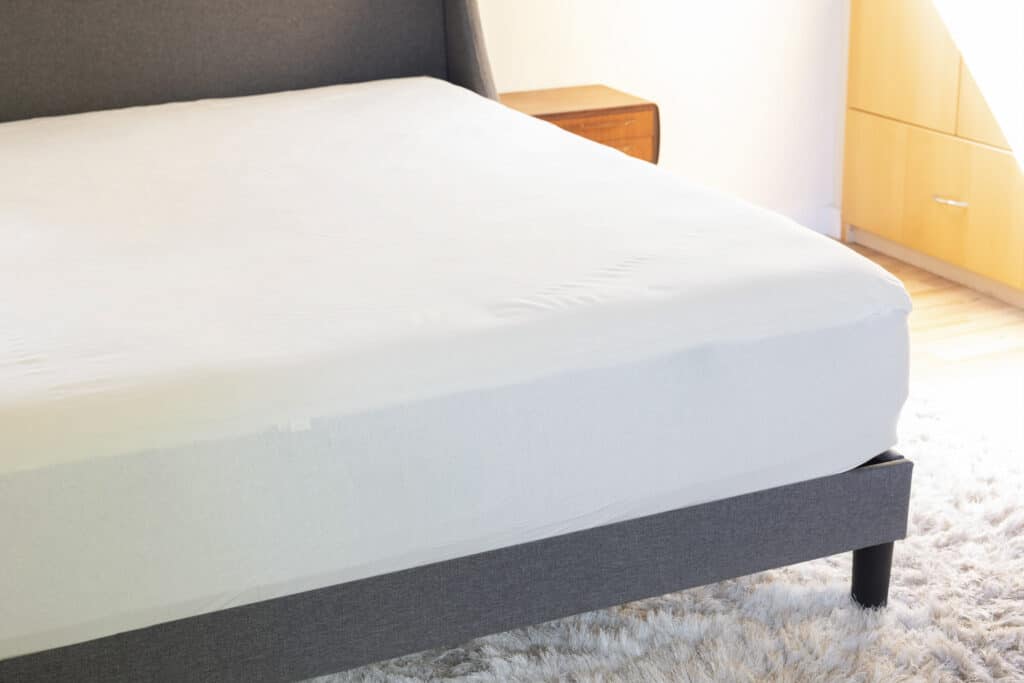Many mattresses carry Greenguard Gold and CertiPUR-US certifications. What do these two seals mean and which one is best for mattresses? Here’s a head to head of CertiPUR-US vs. Greenguard Gold for mattresses.
CertiPUR-US focuses solely on polyurethane foam products, which we never recommend. By contrast, Greenguard Gold certification offers assurance that a product does not emit high levels of volatile organic compounds (VOCs) and otherwise impair indoor air quality.
Greenguard Gold vs. CertiPUR-US
Many mattresses now carry either or both Greenguard Gold and CertiPUR-US certifications. These both pertain to the materials that make up the mattress, but the two aren’t interchangeable.
There are some key differences between Greenguard Gold and CertiPUR-US certifications. In fact, if a mattress carries one of these seals (spoiler alert: CertiPUR!), it has no place in a non-toxic bedroom. And even Greenguard Gold has me on Amber Alert for synthetic materials that off-gas at least a little.
Here are the major differences between Greenguard Gold and CertiPUR-US and how they apply to product safety and environmental impact.

Greenguard Gold
The main purpose of the Greenguard Gold seal is to offer assurance that a certified product does not emit high levels of volatile organic compounds (VOCs) and otherwise impair indoor air quality.
The body behind the Greenguard Gold seal lays out strict limits on VOC levels and other hazardous compounds, such as phthalates, in a mattress (and other products).
To receive a Greenguard Gold seal, a product undergoes testing in controlled environmental chambers. Any emissions from the product are measured under different conditions, such as with higher humidity levels and warmer temperatures.
Greenguard Gold can apply to a variety of products, including:
- Mattresses
- Bed frames and other furniture
- Carpet and flooring
- Paints
- Adhesives.
In contrast, CertiPUR-US focuses solely on polyurethane foam products. There are also other major differences between the two certifications.
Greenguard Gold Emission Limits
| Emission Type | Maximum Allowable Emission Level (µg/m³) after 24 hours |
|---|---|
| Total Volatile Organic Compounds (TVOCs) | 200 |
| Formaldehyde | 9 |
| Phthalates | Varies depending on the specific phthalate |
| Respirable Particulate Matter (PM10) | 50 |
| Respirable Particulate Matter (PM2.5) | 12 |
Specific values for each parameter vary depending on the product category. The limits above pertain to mattresses.
CertiPUR-US
CertiPUR-US mainly applies to the polyfoam in mattresses. You may also see this seal on other products containing foam, such as:
- Mattress toppers
- Pillows
- Couches and padded seats
- Gaming chairs and office chairs
- Car seats
- Baby carriers
- Padded play mats
- Dog beds and cat beds.
The purpose of the CertiPUR-US certification is to offer assurance that the foam component of a product is less hazardous than conventional polyurethane foam. The certifying body, which is led by the polyfoam industry, lays out limits on harmful chemicals such as:
- Formaldehyde
- Ozone depleting chemicals
- Heavy metals (such as lead, cadmium, and mercury).
The CertiPUR-US certification also pays attention to the durability and performance of mattress foam, offering some assurance that CertiPUR-US certified mattresses may last a little longer and perform better than those without the seal.
CertiPUR Emission Limits for Polyurethane Foam in Mattresses
| Emission Type | Maximum Allowable Emission Level (µg/m³) after 72 hours |
|---|---|
| Total Volatile Organic Compounds (TVOCs) | 1000 (after 72 hours) |
| Total Aldehydes | 100 |
| Respirable Particulate Matter (PM10) | 150 |
| Formic Acid | 20 |
| Acetic Acid | 25 |
As with Greenguard Gold, limits for CertiPUR-US also vary depending on product category. The limits above are for polyfoam mattresses.
Differences between CertiPUR-US and Greenguard Gold
You’ll have already noticed some differences between these two prominent seals. Here’s a direct head to head comparison of Greenguard Gold vs. CertiPUR-US:
| Greenguard Gold | CertiPUR-US |
|---|---|
| Focuses on emissions, VOCs, and indoor air quality | Focuses solely on the material composition of polyfoam |
| Applies to the whole product | Applies just to the polyfoam component |
| Stricter limits on VOCs and other hazardous chemicals | Less stringent limits for most chemicals compared to Greenguard Gold |
| Tests for 24 hours | Tests for 72 hours |
| Permits only 200 µg/m³ VOCs after 24 hrs | Permits 1000 µg/m³ VOCs after 72 hrs |
| Permits only 9 µg/m³ formaldehyde after 24 hrs | Permits 100 µg/m³ of all aldehydes after 72 hrs |
| Tests for presence of regulated phthalates | Does not test for phthalates |
| Does not speak to the performance or durability of a product | Includes an assessment of durability and performance of the foam |
As you can see, on most measures, Greenguard Gold is much more stringent than CertiPUR-US. It also covers more chemicals.
Who oversees CertiPUR-US and Greenguard Gold?
Greenguard Gold certification is overseen by UL Environment, rather than an industry body.
UL Environment is a division of Underwriters Laboratories (UL), which is a global safety science company that provides testing, inspection, certification, and verification services to various industries. UL also oversees other green and non-toxic certifications such as EcoLogo.
CertiPUR-US certification is overseen by a non-profit organization called the Alliance for Flexible Polyurethane Foam, Inc. This industry body’s aim is to promote the use of polyurethane foam in mattresses and other household products.

Final thoughts on Greenguard Gold vs. CertiPUR-US
There’s little doubt that Greenguard Gold is a more robust green certification than CertiPUR-US.
Any product with CertiPUR-US certification necessarily contains polyfoam. As such, I use the presence of a CertiPUR seal to help me filter out mattresses that don’t make the cut at Leaf Score.
In contrast, Greenguard Gold is a nice certification to see on a mattress. It shows that a company has put that mattress through stringent testing.
That said, natural mattresses that are made with non-toxic materials to begin with don’t need Greenguard Gold seals. After all, you won’t see any off-gassing or need to worry about phthalates with natural mattress materials such as organic:
- Wool
- Cotton
- Latex.
So, again, if a mattress that seems natural and non-toxic carries Greenguard Gold certification, I’ll usually give it a very thorough analysis. Chances are, there’s some synthetic component that the mattress maker doesn’t highlight.
All in all, neither Greenguard Gold nor CertiPUR inspire much confidence in me when looking for non-toxic mattresses. But if you are going for a mattress that contains some polyfoam or other synthetic materials, Greenguard Gold is certainly the more robust seal, and having both seals is even better as it speaks to durability, performance, and product safety.
See: Most important green mattress certifications and LeafScore top choices for eco-friendly, non-toxic mattresses